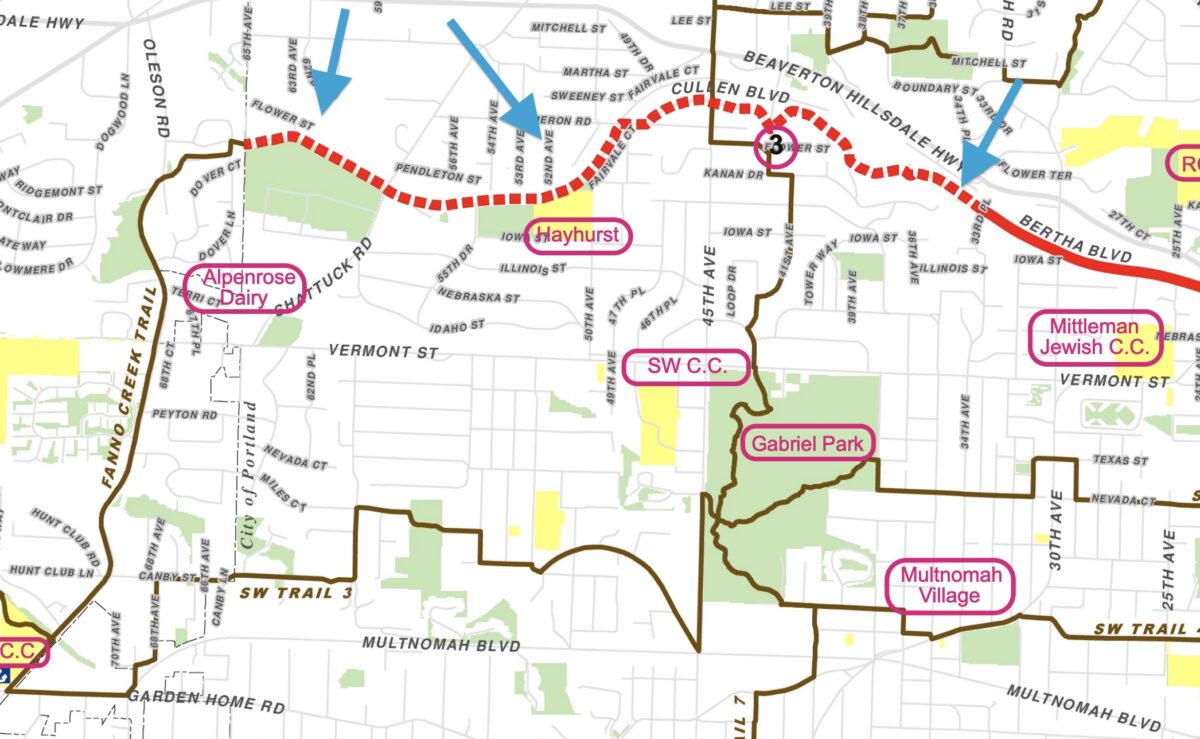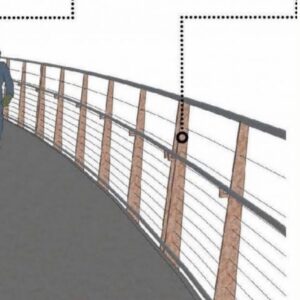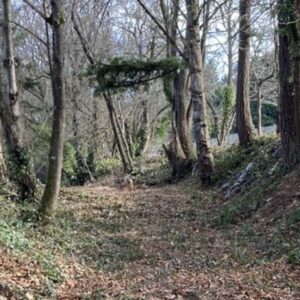
There’s more good news for the Red Electric Trail: Portland City Council will accept a $750,000 grant at their meeting this week that will go toward planning three segments of the future path.
When complete, the Red Electric will be a major east-west artery in the regional path network that will connect the existing Fanno Creek Trail in Beaverton to the Willamette Greenway Trail in Portland’s South Waterfront neighborhood. The 16-mile route follows the historic Red Electric train line which operated for 15 years before closing in 1929.
First adopted by city council as a concept in 2007, work on the project was nonexistent until last year when the city broke ground on a $4.7 million carfree bridge between SW Bertha Blvd and SW Capitol Highway. That project was paid for by a mix of federal grants and local system development charges.
Advertisement
The $750,000 that the Portland Parks & Recreation Bureau will accept at the council meeting Wednesday comes from the American Rescue Plan Act (ARPA) which was approved by Congress to address pandemic impacts.
Parks will use the funding to complete 30% design drawings for three trail segments (shown via blue arrows above): the Alpenrose Dairy site segment, the segment east of Alpenrose Dairy between SW Shattuck Road and SW Cameron Road, and the properties near 3304 SW Bertha Blvd.
“The trail is an important regional connector long planned for construction, and which will benefit local populations impacted by the Covid-19 pandemic,” states the council ordinance, “including public school children at Hayhurst Elementary, park users of Pendleton Park, preschoolers at the Southwest Parent-Child non-profit Co-op, the Marquis Vermont Hills post-hospital long term care facility, and gardeners at the Vermont Hills Community Garden.”
This path (once it’s built) will have even more value and impact for these southwest communities because the area lacks sidewalks and bike lanes and has almost no dedicated “all-ages” infrastructure for walking and biking.
While these funds won’t build a path. “The design drawings will be very helpful in allowing PP&R to advance construction of the designed trail segments in the future,” the ordinance says.
— Download a map of the trail and learn more at SWTrails.org.







Thanks for reading.
BikePortland has served this community with independent community journalism since 2005. We rely on subscriptions from readers like you to survive. Your financial support is vital in keeping this valuable resource alive and well.
Please subscribe today to strengthen and expand our work.
My guess is that unless something changes in this city the trail will never be built because
as soon as it becomes a reality, the neighborhood will oppose it due to it becoming
another neglected gathering for tent campers…I hope I am wrong and something turns around
in this city.
As someone that shows up to Hayhurst neighborhood meetings, people are excited to see the trail come through
Hate to be that person, but how are they going to prevent camping on/along the trail?
If campers set up then people will be less likely to use it.
This is objectively a good thing, but still doesn’t address the critical lack of connections in the triangle between Oleson, Scholls Ferry, and the Fanno Creek Trail. You’d have to be out of your mind to bike through the Beaverton-Hillsdale/Scholls Ferry/Oleson clusterduck, and Garden Home isn’t exactly bike-friendly either. I wish they’d make a very short paved path connecting Vermont between Oleson and Nicol. No need to make a whole new road here, just a short multi-use path.
ODOT and WashCo are awful regarding crash corner. I think some helpful things could be banning new drive-thrus on BH and Scholls Ferry Road, adding numerous street lamps on BH and Scholls Ferry Road, and by putting all utilities underground by crash corner to help sightlines and by planting trees.
That right-of-way on SW Vermont Street is owned by the city of Beaverton, Oregon but they refused to acknowledge that potential even though it is not on a landslide zone or on a creek. WashCo did a bad job with redoing Oleson in 2007 by having many sections with high banking as though it were a car race track.
For those that aren’t familiar with the gap in the Vermont corridor, the Montclair Elementary School campus interrupts Vermont Street on either side of the campus. However, one can walk or ride a bike through the edge of the campus, on essentially what might have been the Vermont ROW, as long as it is outside of school hours of operation. What is interesting is that according to Portland Maps, there seems to be a vestige of ROW, not wide enough for a roadway, but sufficient for a trail, on the north side of the Montclair school property. I agree that it would be great to have a legitimate multi-use path that is not constrained by school district restrictions. This short, 2 or 3 block long segment is key to unlocking an informal route of continuous, low traffic neighborhood streets connecting Beaverton, and territory west of Beaverton, with Multnomah and Hillsdale neighborhoods and the rest of Portland. Because of mostly discontinuous low-traffic neighborhood streets in this part of the metro area, the few connections that exist, like this one, are critical. I cross the Montclair campus regularly and I have seen many other bike riders doing the same. It would be interesting to do a bike count to confirm the popularity of this link. This is at the boundary of City of Portland and City of Tigard jurisdictions, with adjacent property owners Oregon Episcopal School and Beaverton School District. What would it take to get these folks to the table to discuss?
There currently is an “unofficial” path across the Montclair Elementary school property, right along the fenceline by the playing fields, that connects Vermont St, but it’s often muddy in the winter and the fence is occasionally closed. I used to use it frequently. A formal path there seems like it would be so easy to do!
$750,00 in COVID RELIEF FUNDS to be used for a bike path? As if covid is history? How about the newest Omicron variant popping up that is more infectious and deadly? And that new gene (MCR-9) found in Georgia sewer water that causes bacteria to be resistant to antibiotics? Mother Nature is way ahead of simply worrying about homeless campers. Stay tuned!
$750,000 for *drawings*? Some of that money must be going to surveying crews, who work in the cold and rain to map out a potential route – though I can’t see why surveying is even needed on the section east of Shattuck, where you can clearly see the RR cut and even walk through it (if you have a machete to cut through the briars). The section west of Shattuck should definitely be surveyed now, before the Alpenrose site is carved up for condominiums.
Any giant development of the Alpenrose property requires a trail connection to allow people to walk and bike to Oleson. However, the latest drawings of new McMansions on the Alpenrose site shows two streets being punched through to encourage more SUV and motorcycle traffic.